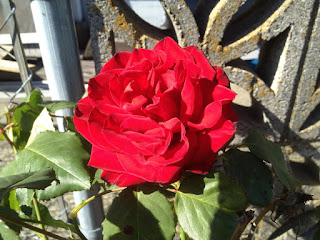 |
| Lovely but could use some companions |
The roses are one of my areas to focus on this year. My plan is to dig out a wider border from the lawn all along both sides, put in plants to create an edge for the lawn, and then a lot of groundcover plants and a few other seasonal interest plants. There are two roses that need to be dug out, they are growing from the roots and whatever was grafted originally is gone. Some of the roses are too close together anyway, so this will help.
The main area gets full sun and is very dry in the summer - but I have a soaker hose run along the roses, and turn that on a couple of times/week in the hottest part of the summer.
The main area gets full sun and is very dry in the summer - but I have a soaker hose run along the roses, and turn that on a couple of times/week in the hottest part of the summer.
 |
| North fence |
I'm planning a combination of lavender and catmint for the lawn edge, with salvia just behind it. I made an impulse buy of ranunculus that will go in there somewhere, columbine seeds to plant, and wild geranium that I can transplant from other areas. Also looking at lambs ear, dwarf yarrow (white or other color, not yellow) and chives. I'll need more groundcover and that's really what I'm weakest at knowing how to plan, so I'm still reading and thinking and observing.
This will be a lot of blue and purple, with a little red (half of the columbine) and silver/grey foliage. I think that will look good with the roses, which are mostly red and pink, and the peonies should be red, pink and white.
The lower section is already wider and has a solid border with a retaining wall. It's also shadier, the roses don't grow quite as well down there. There are already wild geranium coming up through the bark mulch, which I have always weeded out but won't now, and a few vinca minor shoots that I transplanted last year. I'll probably just let those grow, weed out the dandelions and other plants that I don't want, and see what happens.
 |
| Lower section of roses |
The juniper and small section of lawn below it, before the retaining wall starts, will probably go - but not as high of a priority as the rest of the rose area.
There is also a strip of mulch along the sidewalk, all along the outside of the fence to the mailbox in the northwest corner. Orange flowered annuals that I believe are zinnias come up around the mailbox, spread from the neighbor's yard years ago. I'm going to plant other types of zinnias all along that strip to keep out the weeds.
The wisteria growing along the west fence between the roses and the driveway is another matter, it is too much work for too little enjoyment. I'm not sure of the wisdom of planting wisteria anywhere in this climate - except in a large pot - but this seems to be a particularly bad location. There's nowhere for it to climb except the short fence, and new shoots grow into the sidewalk if it's not cut back weekly in the summer. But it's not on my list of priorities for this year. I cut the woody part back heavily in early January and hope that will at least keep it from its annual attempt to encroach into the roses.







